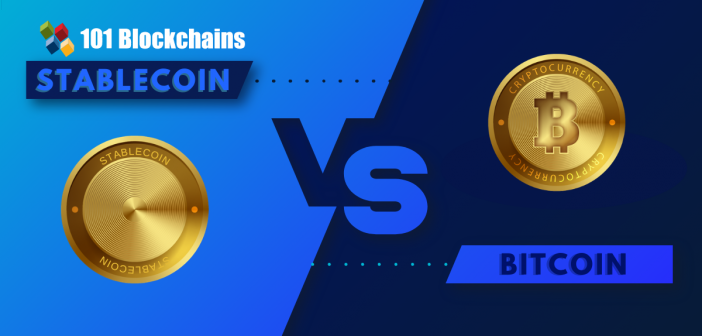Master stability in a volatile world — unlock the power of stablecoins to navigate crypto with confidence. Explore real-world use cases in the Stablecoins Mastery course.

- Bitcoin
Diego Geroni
- on June 02, 2021
Key Difference between Stablecoin and Bitcoin
The following discussion aims to build on this essentials difference between Stabelcoints vs. Bitcoin and explain how they fit perfectly in the domain of cryptocurrencies.
Bitcoin emerged as a formidable intervention in the global economy by redefining the conventional notions underpinning the operations of many financial institutions. It brought the attention of the world to the concept called ‘cryptocurrency’. However, the initial hype surrounding Bitcoin taking over global economic systems subsided over the course of time with pricing fluctuations. Almost everyone started to question Bitcoin for its volatility. This is where the stablecoin vs Bitcoin debate finds prominent priority among investors or businesses in the crypto space. The following discussion takes a dive into the differences between Bitcoin and stablecoin.
There is no doubt that Bitcoin indeed has a formidable command over the cryptocurrency market, with certain exchanges using Bitcoins as the primary source for trading. Although stablecoin is new in the market, there are many ways in which it can outsmart Bitcoin, and in some cases, it could not be the right choice. Bitcoin is the popular choice in the crypto market, and stablecoin, isn’t it? You might want to take a look again at the power of stablecoin vs cryptocurrency. Let us discover the importance of stablecoins and Bitcoin, followed by an outline of their differences.
Want to become a bitcoin expert? Enroll Now in Getting Started with Bitcoin Technology Course
Why Focus on the Difference Between Bitcoin and Stablecoin?
In order to understand the differences between stablecoin and Bitcoin, it is important to focus on the way Bitcoin works. The fluctuation in prices of Bitcoin in comparison to fiat currencies is primarily based on the conflict between the perceived store of value and fiat currency. The properties of Bitcoin ensure that it is basically like gold.
Developers of the Bitcoin community have created a design decision for governance. The design of Bitcoin implies that it would produce only a total of 21 million Bitcoin or BTC. Investors could allocate more or less of their assets to Bitcoin, thereby resulting in profound differences from fiat currency.
The fiat currency is always under the control of governments which impose dynamic management for maintaining low inflation, better growth, and high employment by investing more in capital resources. So, when the economy shows signs of strength and weakness, the value of Bitcoin takes different turns.
The next important aspect that would help in explaining the difference between stablecoin and Bitcoin refers to the perception of intrinsic value of cryptocurrency as a method of value transfer and store of value. Store of value refers to the function through which an asset can be productive in the future with a certain extent of predictability.
In addition, it is possible to save and exchange a store of value for certain products or services in the future. The method of value transfer related to any concept or object could help in transmitting property in the form of assets from one party to another.
Want to learn the basic and advanced concepts of Stablecoin? Enroll in our Stablecoin Fundamentals Course Now!
The Importance of Bitcoin – Understanding the Definition
First of all, let’s start with the crowd favorite. Bitcoin is just being mentioned here because of the relatively higher levels of popularity it enjoys. Bitcoin was the spearhead of the blockchain revolution and came forward in 2009 with the publication of a whitepaper by Satoshi Nakamoto, the anonymous founder of Bitcoin.
Yes, the difference between stablecoin and Bitcoin is that stablecoins don’t have an interesting spy-novel story in their origin. Despite many attempts to find out the true identity of Satoshi Nakamoto, his identity has always been hidden. That, among others, has been a prominent reason for ensuring that Bitcoin retains its mystery aspect.
The world witnessed the arrival of Bitcoin through a whitepaper authored by Satoshi Nakamoto in 2009. Since then, the popularity of Bitcoin has only grown further as a peer-to-peer electronic cash system. Bitcoin was the tool everyone wanted to get rid of the influence of banks over their abilities to carry out financial transactions.
It could allow people to send payments directly without any other financial institution in between. The use of timestamps can provide a detailed audit trail with Bitcoin transactions, showcasing who sent the money at what time, to which party, and the amount in the transactions.
However, the identity of both parties can remain anonymous while proving that the transaction has actually taken place. Now, the stablecoin vs Bitcoin debate will come later in the discussion, although you should remember that Bitcoin has a formidable setback. If you want to know the difference between them, then the following section is very important.
Build your identity as a certified blockchain expert with 101 Blockchains’ Blockchain Certifications designed to provide enhanced career prospects.
Stablecoins as the Answer – Understanding the Definition
So, you could find a formidable setback with Bitcoin in the form of volatility. Many large investors are confused about the prospects of investment with Bitcoin. In such cases, they don’t want to put their valuable investments at the whims of the larger Bitcoin ecosystem. Sudden fall in prices of Bitcoin can be quite overwhelming for many investors, and so, they tend to look for the Bitcoin vs stablecoin difference.
Stablecoin, as the name implies, clearly emphasizes delivering stability in cryptocurrency. It is basically cryptocurrency minus the volatility. There is no doubt regarding the potential of blockchain for disrupting almost every industry. With continuously emerging new use cases, blockchain focuses on developing better and sophisticated payment systems. Fiat currencies all over the world are used for buying goods and services.
Economies all over the world depend on government-issued currency for operations. Stablecoins are aiming to become the cryptocurrency alternatives of fiat currencies. Basically, a stablecoin is a cryptocurrency with the value of an underlying asset as collateral. Most of the stablecoins are found at a 1:1 ratio in comparison with specific fiat currencies such as Euro or the US dollar, which you can trade on exchanges. It is also possible to peg stablecoins against other assets such as gold and precious metals as well as other cryptocurrencies.
Want to become a Cryptocurrency expert? Enroll Now in Cryptocurrency Fundamentals Course
Other Notable Differences between Stablecoin and Bitcoin – Stablecoin vs Bitcoin
Now that you have a clear impression of the importance of Bitcoin and stablecoins, it is reasonable to take the stablecoin vs cryptocurrency debate further. The discussion till now showcases that Bitcoin is at a slightly lesser advantage than stablecoin because of volatility. As a matter of fact, the definitions of both show how Bitcoin is volatile, and stablecoin ensures desired stability in cryptocurrency. However, there is more to the discussion on the difference between stablecoin and Bitcoin. Let us dive further into the other benchmarks for comparing stablecoins with Bitcoin.
Watch This Video To Know About The Key Difference between Stablecoin and Bitcoin Right Now!
-
Types
The foremost criteria for differentiating stablecoin from Bitcoin refer to the different variants of stablecoin. You could find only one Bitcoin, the cryptocurrency platform with BTC as the coin for transactions on the platform. On the contrary, stablecoin features four different types such as fiat-backed, commodity-backed, non-collateralized, and crypto-backed stablecoins. A closer look at the four different types of stablecoins shows how their functionality can outsmart Bitcoin.
Fiat-backed stablecoins are the most commonly used variants that find references in Bitcoin vs stablecoin debate. Fiat-backed stablecoins are supported with fiat currencies such as the US dollar. The value of each fiat-backed stablecoin token is pegged against reserves of the US dollar or any other fiat currency.
The next type of stablecoin refers to commodity-backed stablecoin, which is more or less similar to fiat-backed stablecoin. The primary difference, in this case, is clearly evident as it gets the backing of commodities. Commodity-backed stablecoins can rely on the value of commodities such as silver, gold, or even a bale of cotton.
Non-collateralized stablecoins also make a promising entry into discussions on the difference between stablecoin and Bitcoin. non-collateralized stablecoins do not have the backing of anything, thereby indicating a highly contradictory perception of stablecoins. They rely on algorithms generated through series of mechanical procedures. The algorithms have the ability to change supply volume to maintain the stability of the token price.
The non-collateralized stablecoins are also relying on smart contracts for selling tokens. This ensures that if the price depreciates below the peg, the stable coin can handle it, and it also helps in supply tokens to the market when the value increases. Therefore, it can maintain continuity in the process of stabilizing the cryptocurrency against all detrimental conditions.
Crypto-backed stablecoin is also a vital example for showcasing stablecoin vs Bitcoin debate carefully. It basically serves as a connecting link between the two concepts. It features the backing of the other cryptocurrencies and can be pegged against Bitcoin also. Such types of stablecoins have a certain amount of cryptocurrency in their reserves for backing the coin.
On the other hand, it is also important to note that the volatility of cryptocurrency could lead to price/earnings to growth ratio deviating from the expected 1:1 valuation. However, stablecoins definitely give you the right opportunity to leverage the value of cryptocurrencies while avoiding any losses due to fluctuating values.
If you are curious about Stablecoin and Bitcoin, here’s a free blockchain course that can help you to understand the context behind both of these terms.
-
Use Cases
When the discussion takes a serious turn into the Bitcoin vs stablecoin differences, it is reasonable to notice the applications. The uses of Bitcoin and stablecoin can show a lot about the differences between them. In the case of Bitcoin, you can notice a peer-to-peer payment system. It can be used for making cross-border payments within a matter of a few seconds or minutes, and it also reduces the transaction fees.
Bitcoin is also capable of providing the advantage of privacy and integrity of transactions recorded on the Bitcoin blockchain. Most important of all, Bitcoin is largely employed in exchange and trading platforms. Investors all over the world buy and trade in Bitcoin with the backing of real-world assets while taking the market trends into account. Depending on the rising and falling trends of the Bitcoin market, traders have to make reliable decisions about their investments.
On the other hand, stablecoin has the potential to serve various real-life use cases owing to its nature. It can be pegged against the national currency of a country and serve as a suitable method of making digital payments. In such cases, stablecoins can offer the advantages of cryptocurrency while also ensuring that their values are constant.
It’s just like converting a dollar in your bank account into a token in a specific stablecoin platform. Most important of all, the assurance of stability in stablecoin vs cryptocurrency is a great prospect for addressing real-life use cases. When you know that the stablecoin value will not change and shall stay the same as that of the currency in your nation, it may be useful as a tool for improving economic activities in society in general.
Another promising example of real applications of stablecoin includes streamlining the P2P payments with smart contracts. The use of smart contracts can ensure that they could execute code automatically for triggering exchange between two counterparties with a third party for enacting. Most important of all, stablecoins can help in safeguards against crashes in local currency.
Curious to understand the complete smart contract development lifecycle? Enroll in Smart Contracts Development Course Now!
-
Level of Control
The final aspect that dictates the difference of stablecoin vs Bitcoin comparison refers to the control over asset value. Bitcoin has the capability of predicting the price direction for other coins alongside ensuring promising synchronization of the whole crypto market with Bitcoin. On the other hand, stablecoins are always dependent on some asset or fiat currency for their value. Therefore, you cannot dictate the returns you can receive with stablecoins.
Bitcoins have the factor of volatility, albeit with the option of cashing out your fortune in Bitcoin. If the prices are about the drop, then convert the Bitcoin into cash and enjoy the fortune. However, a stablecoin does not have any signs of appreciation, and it will be the same value as the national currency or the asset that backs it.
You can take a look at the difference between stablecoin and Bitcoin in the following table.
| Criteria | Bitcoin | Stablecoin |
|---|---|---|
| Definition | Peer-to-peer cash system based on blockchain First mainstream cryptocurrency | Cryptocurrency with the backing of commodities, fiat currency, or any other real-world assets |
| Types | Only one variant of Bitcoin is available. | Four types of stablecoins are available depending on the asset backing them. The types of stablecoin include, 1. Fiat-backed stablecoin 2. Non-collateralized stablecoin 3. Commodity-backed stablecoin 4. Crypto-backed stablecoin |
| Uses | Exchanging and Trading Electronic payments | Digital payments and many other real-world use cases of payments involving cryptocurrency. |
| Level of Control | Investors can leverage volatility for cashing out when the time is right. | No opportunities for achieving improved returns than existing fiat currency or asset value. |
Final Note
On a final note, it is quite clear that stablecoin vs cryptocurrency like Bitcoin is indeed a crucial debate. The comparison between both cryptocurrency alternatives shows that they can transform the digital financial ecosystem with diversity in use cases. It is quite clear that Bitcoin is definitely an industry leader in cryptocurrency. However, stablecoins have come up with a solution to one of the foremost weaknesses of Bitcoin.
The adoption of stablecoins is a clear indicator of their growing popularity and can be integral components of the crypto ecosystem in the future. Learn more about Bitcoin and stablecoins to know about their potential for transforming finance as we know it.
*Disclaimer: The article should not be taken as, and is not intended to provide any investment advice. Claims made in this article do not constitute investment advice and should not be taken as such. 101 Blockchains shall not be responsible for any loss sustained by any person who relies on this article. Do your own research!





